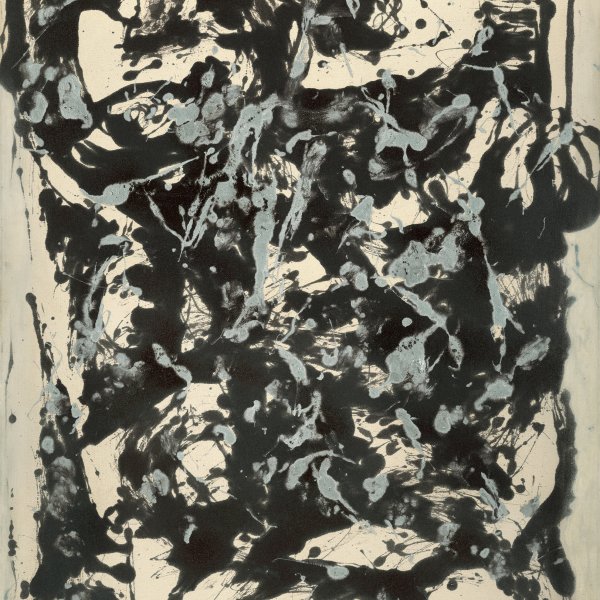Jackson Pollock
Cody, 1912-The Springs, 1956
The American painter Jackson Pollock is the foremost practitioner of Action Painting and has become a legend owing to his revolutionary conception of art, his life of excesses, and his death following a car accident when he was at the peak of his career.
Pollock began studying at the Manual Arts High School in Los Angeles in 1928 and joined two of his five brothers in New York in 1930. He studied under the mural painter Thomas Hart Benton at the Art Students League and was able to move out of the precarious situation he had lived in until then when he was hired by the Works Progress Administration as a mural assistant. In 1936 he took part in a workshop run by David Alfaro Siqueiros, which allowed him to experiment with different techniques such as airbrushes, paint guns and the use of enamel and other synthetic and industrial paints that later made their appearance in his work.
In 1938 Pollock began to undergo the first of many psychiatric treatments to attempt to overcome his alcoholism. The Jungian analysts who treated him until 1941 used his drawings as part of the therapeutic process. In them he obsessively explored his subconscious in a style close to that of Picasso, Orozco and Miró. The painter Lee Krasner moved into Pollock’s studio in 1942 and married him in 1945. The following year Peggy Guggenheim visited his studio and soon afterwards staged a one-man show of his works at the Art of this Century gallery and commissioned him to paint a mural for her home. Pollock’s new financial situation enabled him to buy a country house in The Springs, East Hampton, and convert a straw loft into his studio. This was the most prolific period in the career of the artist, who in 1946 began to work by placing the canvas on the floor and splashing it with paint, sand and other elements to create more of a texture.
The exhibitions held at Peggy Guggenheim’s gallery during the years that ensued, followed by others at the gallery belonging to Betty Parsons, his new dealer since 1948, established him as one of the great figures in American art. His international fame received its definitive impetus when Life magazine published an article entitled “Jackson Pollock: Is he the greatest living painter in the United States?” illustrated with photographs showing him pouring paint onto his canvases. However, Pollock was suffering from another of his crises and was painting increasingly less. In 1956 he crashed his car into a tree near his home in The Springs.
Pollock began studying at the Manual Arts High School in Los Angeles in 1928 and joined two of his five brothers in New York in 1930. He studied under the mural painter Thomas Hart Benton at the Art Students League and was able to move out of the precarious situation he had lived in until then when he was hired by the Works Progress Administration as a mural assistant. In 1936 he took part in a workshop run by David Alfaro Siqueiros, which allowed him to experiment with different techniques such as airbrushes, paint guns and the use of enamel and other synthetic and industrial paints that later made their appearance in his work.
In 1938 Pollock began to undergo the first of many psychiatric treatments to attempt to overcome his alcoholism. The Jungian analysts who treated him until 1941 used his drawings as part of the therapeutic process. In them he obsessively explored his subconscious in a style close to that of Picasso, Orozco and Miró. The painter Lee Krasner moved into Pollock’s studio in 1942 and married him in 1945. The following year Peggy Guggenheim visited his studio and soon afterwards staged a one-man show of his works at the Art of this Century gallery and commissioned him to paint a mural for her home. Pollock’s new financial situation enabled him to buy a country house in The Springs, East Hampton, and convert a straw loft into his studio. This was the most prolific period in the career of the artist, who in 1946 began to work by placing the canvas on the floor and splashing it with paint, sand and other elements to create more of a texture.
The exhibitions held at Peggy Guggenheim’s gallery during the years that ensued, followed by others at the gallery belonging to Betty Parsons, his new dealer since 1948, established him as one of the great figures in American art. His international fame received its definitive impetus when Life magazine published an article entitled “Jackson Pollock: Is he the greatest living painter in the United States?” illustrated with photographs showing him pouring paint onto his canvases. However, Pollock was suffering from another of his crises and was painting increasingly less. In 1956 he crashed his car into a tree near his home in The Springs.





